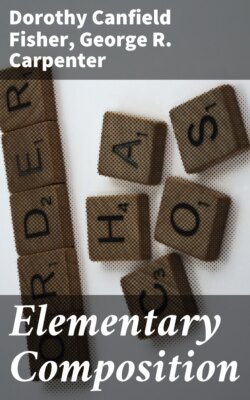| | Chapter II. The Sentence |
| EXERCISES | PAGES |
| 1–3. | Distinguishing and constructing phrases, clauses, and sentences | 5, 6 |
| 4–13. | Distinguishing and constructing simple, complex, and compound sentences | 7-13 |
| 14, 15. | Variety in the form and length of sentences | 15, 16 |
| 16. | Distinguishing the periodic sentence | 19 |
| 17–21. | Constructing the periodic sentence | 19-21 |
| 22–24. | Distinguishing and correcting the "comma" sentence | 22, 23 |
| 25. | Correcting sentences that are without unity | 24 |
| 26, 27. | Reconstructing formless sentences | 26-28 |
| | Chapter III. The Paragraph |
| 28. | Noting the force of topic sentences | 33 |
| 29. | Supplying topic sentences | 34 |
| 30. | Writing short paragraphs from topic sentences | 35 |
| 31. | Noting when and why paragraphs lack unity | 36 |
| 32. | Making notes for paragraphs suggested by topic sentences | 40 |
| 33. | Correcting bad division into paragraphs | 41 |
| 34. | Making notes for paragraphs suggested by summary sentences | 43 |
| 35. | Making summary sentences for paragraphs indicated by notes | 44 |
| 36–38. | Use of quotation marks | 46-48 |
| | Chapter IV. Words |
| 39–45. | Increasing the vocabulary | 51, 52 |
| 46–52. | Synonyms | 53-57 |
| 53. | Distinguishing between similar words | 59 |
| 54–60. | Metaphors and similes | 60-62 |
| 61–62. | Slang | 64 |
| 63–66. | Errors in the forms of words | 65-67 |
| | Chapter V. Condensation, Expansion, and Paraphrase |
| 67. | Condensing paragraphs | 70 |
| 68–69. | Condensing longer passages | 75-77 |
| 70. | Expanding short and suggestive statements | 79 |
| 71. | Expanding for the sake of clearness | 80 |
| 72–73. | Paraphrasing short passages | 82-84 |
| 74. | Paraphrasing complete poems | 87 |
| | Chapter VI. Whole Compositions; Outlines |
| 75–76. | Preparing outlines | 96, 101 |
| | Chapter VII. Oral Composition |
| | Chapter VIII. The Diary |
| 77. | Imaginary diaries | 109 |
| | Chapter IX. The Letter |
| 78. | Friendly letters | 118 |
| 79. | Letters of social intercourse | 121 |
| 80. | Formal invitations | 123 |
| 81. | Telegrams | 124 |
| 82–84. | Business letters | 126, 128, 129 |
| 85–87. | Notices | 131, 132 |
| 88. | Appeals | 134 |
| 89. | Petitions | 135 |
| 90–91. | Advertisements | 135, 136 |
| | Chapter X. Narration |
| 92. | Fables | 138 |
| 93. | Autobiographical sketches | 141 |
| 94–96. | Biographical sketches | 142, 143 |
| 97. | Historical sketches | 150 |
| 98. | Reporting facts | 152 |
| 99. | Fables told by conversation | 153 |
| 100–101. | Imaginary conversations | 153, 154 |
| | Chapter XI. Description |
| 102. | Practice in accurate observation | 157 |
| 103–104. | General scientific description | 162 |
| 105–107. | Specific scientific description | 163, 164 |
| 108–109. | Literary description | 168, 169 |
| 110–111. | Description of people and animals | 170, 171 |
| 112. | Longer descriptions | 173 |
| 113, 114. | Description of conditions | 175, 176 |
| 115. | Description by contrast | 177 |
| 116. | Description of events | 179 |
| 117, 118. | Picture making of scenes of action | 180, 181 |
| 119. | Sketches of travel | 185 |
| 120. | Descriptions of an hour | 187 |
| | Chapter XII. Narrative (Continued) |
| 121, 122. | Historical stories | 190, 191 |
| 123. | Fictitious stories | 193 |
| 124. | Completing stories, when the beginning is given | 194 |
| 125. | Completing stories, when the ending is given | 196 |
| 126. | Completing stories, when the plot is suggested | 198 |
| | Chapter XIII. Exposition |
| 127–129. | Explanation of processes | 203, 204 |
| 130–131. | Explanation of games, sports, etc. | 206 |
| 132. | Explanation by comparison and example | 209 |
| 133. | Explanation (general) | 211 |
| 134. | Explanation of proverbs and quotations | 212 |
| 135. | Explanations of national festivals | 213 |
| | Chapter XIV. Argument |
| 136. | Statement and definition of subject | 216 |
| 137. | Pleas | 221 |
| 138. | Argument (general) | 222 |
| 139. | Giving reasons for personal preference | 223 |
| | Chapter XV. Secretarial Work |
| 140–141. | Minutes, official letters, etc. | 228, 230 |
| | Chapter XVI. Versification |
| 142. | Arranging verse in stanza form | 240 |
| | Completing rhymes | 241 |
| 143–144. | Putting fables into verse | 243 |
| 145. | Writing letters, invitations, and stories in verse | 245 |
| | Chapter XVII. Punctuation |
| 146. | The semicolon | 251 |
| 147. | The colon and the semicolon | 252 |
| 148. | The comma | 257 |
| 149. | Punctuation of direct quotations | 260 |
| 150. | Punctuation of partial quotations | 262 |
| 151. | Punctuation of quotations within quotations | 262 |
| 152. | Capital letters | 265 |
| 153. | Review of punctuation | 266 |
